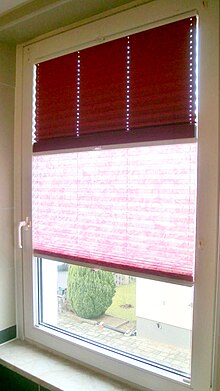Pleated system
A type of sun protection on the window that is related to a roller blind is called a pleated system . However, the fabric is not rolled up on a shaft like with a roller blind , but is pre-folded ( pleated ) and is pushed together into a package like an accordion . The designations are for the facilities pleated , Roman blinds , Plisseevorhang or shortening pleated common.
Pleated systems are among the most versatile models in the area of internal sun protection, as they can be produced in many geometric shapes. In addition to rectangular systems, there are also triangular , trapezoidal or semicircular pleated systems. The top and bottom rails of the system can also be movably mounted so that pleated curtains only shade parts of the window as required.
While roller blinds or venetian blinds are always attached to the upper sash or above the window, pleated blinds can be installed more flexibly. Since pleated blinds can also be operated from bottom to top, the pleated blinds can also be attached to the lower edge of the window and in the middle of the window. By combining different setting positions on several windows next to each other, the often barren-looking surface is visually broken up and the pleated blinds create an interesting, decorative impression.
By installing additional, movable rails in the middle, the systems can also be equipped with two different fabrics, for example with an opaque and translucent fabric for the day and a darkening fabric to completely protect rooms from light if necessary. The desired light transmission can be changed with a single movement (so-called day / night systems).
Pleated blinds are operated either with handles, pull cords, pull chains or electrically. Tensioned and free-hanging models are available for pleated blinds. The biggest difference between these two types lies in the maximum possible dimensions within which a pleated blind can be manufactured. Free-hanging systems can be produced in a larger width, as the fixed top rail cannot bend even if the system is heavier.
Pleated blinds have been developed for vertical installation, with a recommended maximum inclination, as is the case, for example, with bottom hung windows when they are open. There are special solutions for larger inclinations of windows. For example, pleated skylights are available with side guide rails that provide additional support for the system. So-called ceiling systems are available for winter gardens . These are made with additional wire ropes and thus even enable horizontal installation on the ceiling.
The fabrics used are divided into different degrees of transparency and can also be provided with a coating on the back to reflect sunlight - and thus heat - particularly well. The coatings can be vapor-deposited to ensure good heat reflection with simultaneous translucency, or they can be applied to the fabric as an additional layer in white, silver or mother-of-pearl. These substances are then completely opaque.
The degrees of transparency at a glance:
- Transparent: Transparent pleated fabrics have a similar effect to curtains and are attractive room decorations. They provide light privacy and sun protection.
- Semi-transparent: Semi-transparent pleated fabrics provide better privacy protection than the transparent pleated blinds, whereby the translucent fabrics allow sufficient brightness into the room.
- Dimout: A dimout pleated blind darkens the window considerably and hardly lets any light into the room, which is why dimout fabrics are primarily used in the bedroom or at the computer workstation.
- Blackout: A blackout pleated blind offers very dense fabrics. These fabrics create a complete blackout.
Manufacturing and fabric variants
Basically, pleated fabrics are manufactured using pressure, heat and moisture. A distinction is made between manual and machine production:
Manual production : The fabric is fixed using cardboard templates that enclose the fabric web as a bottom and top sheet. The folds are permanently worked into the fabric by hand using heat and steam.
Machine production: This form of production allows a wider range of folds. The width of the folds and their placement can be freely determined. Furthermore, the fabric can be treated, for example, by distorting, blasting or crushing (here the fabric is compressed, the surface then looks like crumpled paper). The machine-made pleated blinds also have to be fixed with steam and heat.
The material plays a major role in the manufacture of pleated fabrics. Natural fibers such as silk and wool, for example, cannot be pleated permanently. Polyester blends with a fabric content of approx. 45% or more are particularly suitable for permanent wrinkles.
Honeycomb pleated systems represent a further development of pleated systems . Compared to conventional pleated systems, the curtain is designed twice. The resulting air cushion between the two connected, pleated lengths of fabric has a positive effect on thermal insulation and room acoustics. The vertically running cords and punched holes necessary for the construction of pleated blinds remain hidden between the fabric panels in honeycomb pleated blinds. The possible area of application (window shapes, bracing) as well as the available design colors and patterns correspond to those of classic pleated systems. The disadvantage of pleated honeycomb systems, on the other hand, is the more complex cleaning.
Individual evidence
- ↑ Pleated blind production: from design draft to finished sun protection. Retrieved September 9, 2016 .



